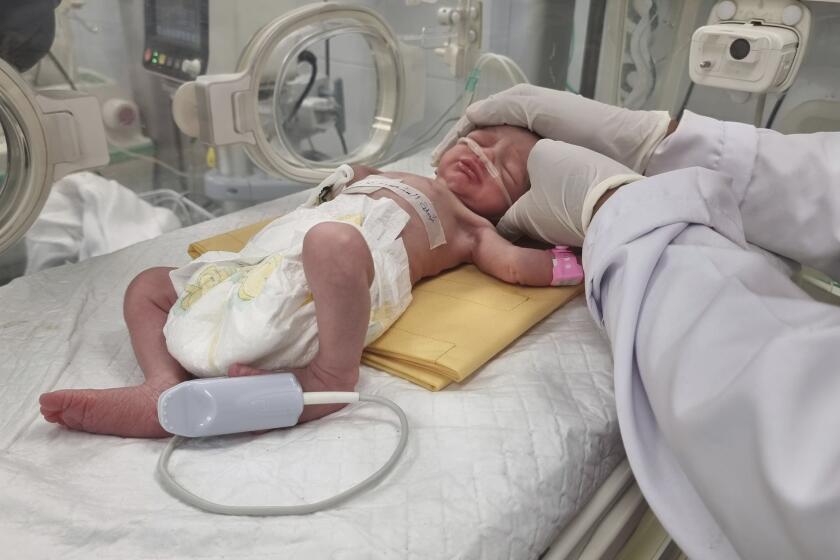Northern Ireland united in mourning Catholic police officer
If anything was symbolic of Northern Ireland as a more hopeful, more harmonious work-in-progress, it was the tiny province’s new police force.
With more Roman Catholics in its ranks than ever before, a force that was a Protestant bastion and viewed as a harsh instrument of British rule has embarked on a slow-but-steady transformation into one dedicated to protecting the entire community. Where officers once patrolled in armored vehicles, they now ride in squad cars and on motorcycles.
So it was that hundreds of mourners from across the political and religious divide filled a church Friday in the town of Banbridge to pay their last respects to the first officer of the revamped force to be gunned down by a republican splinter group opposed to Northern Ireland’s peace process.
Constable Stephen Carroll, 48, was slain Monday in an attack that came two days after the fatal shooting of two British soldiers, also by republican dissidents. The killings shocked Northern Ireland, galvanizing residents and politicians alike, who rallied against a possible retreat to the armed conflict that claimed more than 3,500 lives.
The loss of Carroll, a Catholic and veteran officer, stood for more than just another tragic death in the line of duty, Canon Liam Stephenson told the mourners.
“It represents all of us,” Stephenson said, referring to the Police Service of Northern Ireland. “It is essentially a part of us. An attack on the PSNI is primarily an attack on the whole population of Northern Ireland.”
In a sign of how much has changed since the so-called Good Friday agreement was signed in 1998, ending decades of armed conflict between Catholic republicans and Protestant loyalists, Stephenson’s audience included representatives of Sinn Fein, the former political wing of the Irish Republican Army.
It was the first time that a Sinn Fein leader had attended the funeral of a police officer killed by republican dissidents, a dramatic shift from the days when the IRA routinely targeted the police.
Those were in the days when the very name of the police force proclaimed its loyalty to the British crown: the Royal Ulster Constabulary. But as part of the new power-sharing arrangement ushered in by the 1998 peace accord, the force has undergone a re-branding.
Now, Catholics account for about a quarter of the force, up from 5%. Eventually, the ranks are to be evenly divided between Catholics and Protestants.
Earning public trust has taken time, especially in Catholic neighborhoods that nurse bitter memories of the sometimes brutal tactics used by the old constabulary. On the other side, some Protestants who saw the police as “their boys” are skeptical of the reconstituted force.
But there has been some progress in winning hearts and minds. In November, Catholics and Protestants came together in grief over the deaths of four on-duty police officers -- two from each community -- in a car accident.
Though a veteran of the force, Carroll in some ways reflected the broadened character of the new police. Besides being a Catholic, he was born in England and had lived both there and in Northern Ireland.
Carroll was shot in his police patrol car Monday night while responding to an emergency call in the republican stronghold of Craigavon. The Continuity IRA, a dissident group, has claimed responsibility for the attack.
Authorities have detained a 37-year-old man and 17-year-old youth for questioning. No arrests have been made yet in the shooting of the two soldiers in County Antrim.
Carroll’s widow, Kate, said she hoped that her husband’s death would not be in vain.
In an interview with local television Thursday, she said she hoped dissidents would realize that “we only get one chance at life, and a piece of land is a piece of land. . . . My husband is just going to get 6 foot by 6 foot, and that’s all any of us are going to get.”
Carroll, a grandfather, was expected to retire from the force next year and had taken courses to become a personal trainer.
The police service he loved is still grappling with the transition from a quasi-anti-terrorist force to a community institution dealing with more mundane law-and-order issues. But some analysts are concerned that the process has left gaps in its ability to gather intelligence about the splinter groups responsible for the recent attacks.
At the same time, public expectations are being shifted as well, especially in areas where petty crime is on the rise. During the so-called Troubles, the IRA often administered its own swift, retributive justice to common criminals in heavily republican neighborhoods. Some residents nowadays complain about what seems to them the slow and ineffectual workings of the police.
It is unclear whether Carroll’s killing will cause the police service to change, at least temporarily, some of its operational methods -- for example, by putting officers back in more heavily armored vehicles.
But Carroll’s memorial service rang with the mantra repeated over and over in Northern Ireland these last few days: The violence of the past must remain there.
“So much has been gained since the signing of the Good Friday agreement,” Stephenson said, looking down from the pulpit at Carroll’s flower-draped coffin and a wooden table bearing the police officer’s hat and medals.
“All fair-minded people do not wish to see this progress lost or compromised.”
--
More to Read
Start your day right
Sign up for Essential California for news, features and recommendations from the L.A. Times and beyond in your inbox six days a week.
You may occasionally receive promotional content from the Los Angeles Times.






